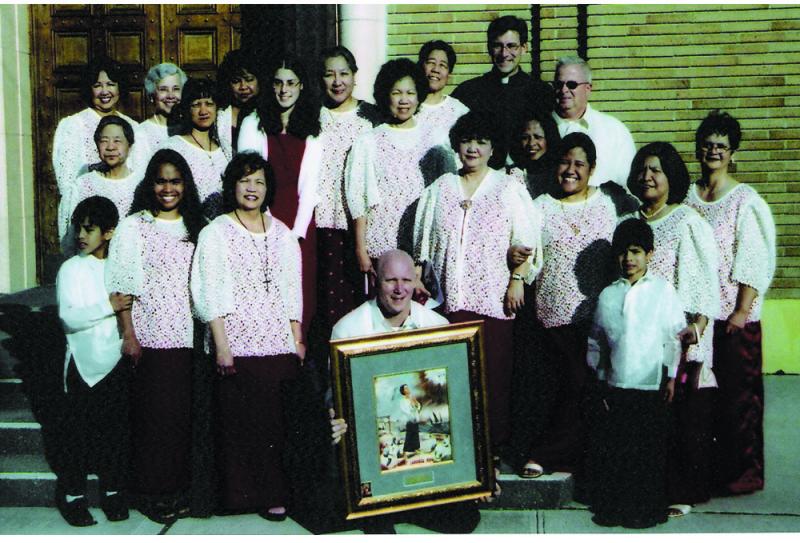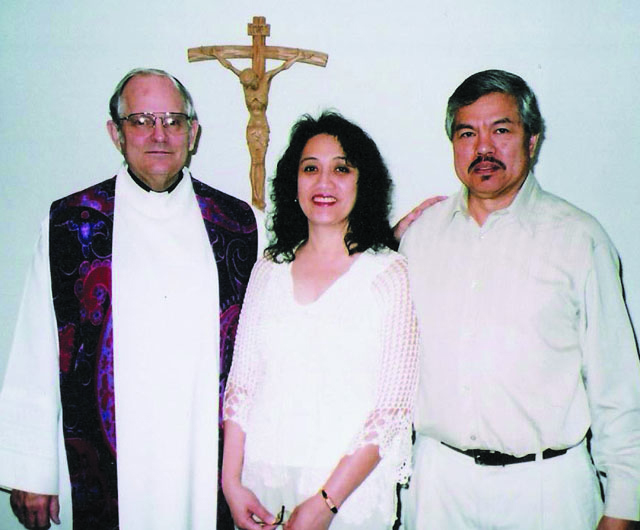San Lorenzo Ruiz: Beloved In Bremerton
By Suzanne Goloy-Lanot
The author, from San Juan, Metro Manila, lives with her husband Leonardo, from Mandaluyong City, in Bremerton, Washington State, USA, with their daughter Adrienne Marie and son Jean-Lenard, both young adults. This is her second article in Misyon.

Some members of the San Lorenzo Ruiz Guild pose with Fr Patrick Freitag (top row, second from right), parish priest of Our Lady, Star of the Sea Parish, before the special mass honoring the saint. Also in photo is Dr Telly Muldong-Tantay ( top row, fifth from right), founder of the guild.
Twenty-five years ago, I worked with one of the nation’s leading financial institutions in the Chinese district of Manila, within walking distance of Binondo Church. At that time, there was much talk about the beatification of Filipino martyr Lorenzo Ruiz. This was wonderful news to me, knowing that someone who once walked the very streets I walked on and who once worked in the very same area I worked in had made a connection with heaven! This made me aware that heaven had come closer to earth.
Born in Binondo in the early 1600s to a Chinese father and Filipino mother, Lorenzo Ruiz was educated by the Dominicans, served as a sacristan, and worked as a calligrapher at Binondo Church. He was married with three children but unfortunately was implicated in a murder that he didn’t commit. He fled the country with a missionary expedition that ended in Nagasaki, Japan, where he was tortured and executed because of his faith. Beatified on 18 February 1981 at Luneta Park, Manila, by Pope John Paul II and later canonized on 18 October 1987 in Rome, Lorenzo Ruiz became the first Filipino saint, his feast day celebrated on 28 September.

Fr Jack Buckalew, the author and her husband Leo
In veneration of San Lorenzo Ruiz de Manila, numerous religious and secular institutions, establishments, and organizations were named in his honor. His death in a foreign land inspired countless Filipinos overseas to recognize and glorify him as their patron saint. His feast day is celebrated in a variety of ways in different parishes among Filipino communities all over the world. With the unrelenting support of their respective parish priests, Fr Patrick Freitag and Fr Jack Buckalew, the parishes of Our Lady, Star of the Sea, (www.starofthesea-bremerton.com) and Holy Trinity (www.holytrinityparishkitsap.org) in Bremerton, Washington State, are no exceptions.Bremerton is divided by the waters of Port Washington Narrows with Our Lady, Star of the Sea, on the west and Holy Trinity on the east working together in ministering to the city’s Catholic community.
Our Lady, Star of the Sea Parish
The San Lorenzo Ruiz Guild of Our Lady, Star of the Sea, began as a First Saturday Reparations prayer group in May 1994. In February 1995 it converted into a weekly prayer meeting. In December of that year, the devotion to the Chaplet of the Divine Mercy was formed. The group, realizing they could accomplish more than just pray, finally established the guild on 19 March 1998 after a slow process of evolution under the leadership and painstaking efforts of Telly Muldong-Tantay, a retired physician with the rank of captain in the United States Navy.
Membership is not exclusive to Filipinos but is open to all Catholic families and at present boasts of 45 family memberships as it continues to grow. Two categories of membership exist - active and praying. The guild, its members, and affiliates are further enrolled in the National Asian Pacific Catholic Organization (NAPCO) in Ontario, California.
Guild functions include, but are not limited to, the management and fundraising efforts for various pastoral projects and activities, mainly the parish’s observance of the feast of San Lorenzo Ruiz and, since its inception in 1997, the annual Simbang Gabi celebrations of the Archdiocese of Seattle (www.seattlearch.org) in its 82 parishes under the inspirational leadership of Archbishop Alex J. Brunett. It promotes Filipino culture by its participation in various year-round multicultural expositions in Western Washington, the area covered by the archdiocese. It provides financial assistance to charitable organizations in the Philippines, the United States, and other countries, and food and shelter for the homeless men of the community in December. It manages the reception dinner after the semi-annual communal administration of the sacrament of the sick.
The parish celebrates the feast of San Lorenzo Ruiz on the Friday evening closest 28 September with a special Mass and reception. This year’s celebration will incorporate the centennial commemoration of Filipino migration to the United States. Clad in identical barong and kimona,the design varying each year, guild members look stunning as they usher in the guests, presenting them with programs and souvenirs.
The Mass begins with a short procession of the two-by-three foot framed religious icon of San Lorenzo escorted by four candle-bearing altar servers. The icon is a depiction of the saint in Nagasaki with various illustrations relating to his martyrdom, particularly the hanging pit, the most horrible form of execution in those days. It is positioned on Mary’s side of the sanctuary. After Holy Communion, Felix Fabellano, Pastoral Assistant for Youth and Young Adults, leads the congregation in his original composition, ‘Viva, San Lorenzo.’
The Camerman Hall, named after Monsignor Joseph Camerman, a Belgian priest who spearheaded the parish expansion project in the 1950s, is the venue for the multicultural fellowship celebration where a five-foot solid wooden statue of San Lorenzo in an exquisitely carved barong is displayed. The statue, a donation from a generous guild member, stays in the home of the hermana mayor of the particular year. Guests are welcomed with an exhibit of the art, culture, and history of the Philippines.
Projecting an image of cultural distinctiveness, explanatory texts and artifacts set the stage for exploring this nation of islands. The exhibit is divided into two main groups: spiritual and educational. The spiritual category lays emphasis on the different feasts held throughout the year: January, Sto Niño; February, Our Lady of Lourdes; March or April, the Easter Triduum; June, the Sacred Heart; July, Our Lady of Mount Carmel; August, the Assumption; September, San Lorenzo Ruiz; October, Our Lady of the Rosary; November, All Souls; December, Simbang Gabi and the Nativity. The educational category accentuates Filipino heroes, books about the Philippines, native crafts, and the different images and shrines of the Blessed Mother in the country.
The festive table is laden with multi-ethnic specialties to accommodate the taste preferences of all nationalities. From the delightfully simple to the extraordinarily exotic, every last morsel is there to be savored. An evening of wholesome family entertainment includes a variety of multiethnic music, song, and dance. A professional Filipino dance troupe with members ranging from in age from five through young adulthood presents a rich repertoire of dances reflecting the influence of major civilizations on the Filipino heritage. Japanese martial arts, Hawaiian, Tahitian, and other Polynesian dances are equally entertaining. A fun selection of sing-along songs entices everyone to join in. However, the evening is never complete without the hilarious antics of Felix Fabellano and his entourage.
Holy Trinity Parish
In June 2001 the same generous devotee of San Lorenzo donated a four-foot resin statue of the saint clothed in an intricately embroidered barong to my parish, Holy Trinity, with the hope that the gift would unite all Filipinos. Although a guild has not been established in his honor, the observance of his feast day is organized and managed by members of the Bukas Loob sa Diyos (Open in Spirit to God)Covenant Community, simply known as the BLD.
On the feast of San Lorenzo Ruiz, his statue, adorned with roses, is displayed in the parish sanctuary during all weekend Masses. On the Saturday nearest his feast, a parish banner imprinted with the saint’s image and the sacred statue borne closely behind it lead the congregation in a simple procession around the perimeter of the church’s parking area, commencing this annual event. Holding lit candles that rival the bright afternoon sun, parishioners join in songs of worship and praise to the accompaniment of folk guitars.
A narrative about the saint’s life precedes a regular Mass that is highlighted with a musical arrangement of ‘Awit kay San Lorenzo’ (San Lorenzo Ruiz Hymn) by Joyce Paxson, Pastoral Assistant for Music. This rendition, made more special because the parish music ministry team, its members of diverse ethnicity, performs it, resonates deeply in the hearts of the Filipino community.
After the Mass, the statue is ushered into the social hall where a banquet of scrumptious Filipino delicacies and delightful cultural entertainment await the congregation. Guests are immersed in an ambiance of Filipino hospitality and are provided with an array of mouth-watering cuisine. Although a succulent lechon (roast pig) holds the place of honor on the festive table, entrees like pancit, adobo,and lumpia as well as native desserts like puto and leche flan are extremely favored by non-Filipino guests.
The evening continues with Filipino song and music, featuring many of our native dances and distinctive costumes. The grand finale is the anticipated presentation of the Tinikling (bamboo dance) since it generates a sense of fun along with the enthusiasm and opportunity to participate in an activity that demands the grace and skill of quick movement by its performers. Laughter fills the room as guests take on the challenge to escape the rapidly clapping bamboo poles.
This tradition of paying homage to a patron saint clearly demonstrates how we Filipinos continue to embrace the richness of our culture and its fervent Catholic faith with mind, heart, and spirit, thereby promoting Filipino Christian values and its diverse cultural heritage in a foreign land. For Filipino immigrants like me, it also creates an air of nostalgia reminiscent of the traditional hometown fiesta, enriched by a strong Spanish religious influence that has been absorbed into the Filipino way of life.
Twenty-five years ago, the beatification of a Filipino martyr was a mere probability. Today, his sainthood is a profound reality. The vision for the future is the universal devotion to San Lorenzo Ruiz de Manila, whose life, imbued with religious fervor, is an excellent example for all Christians since it provides a good context within which to know, love, and serve God.
You may contact the author at sumgl57@yahoo.com.